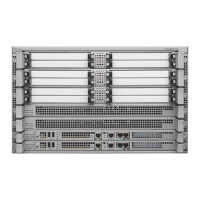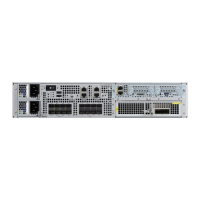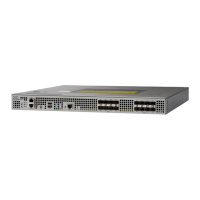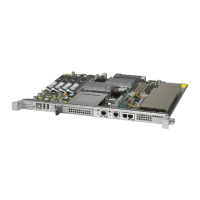19-18
Cisco ASR 1000 Series Aggregation Services Routers SIP and SPA Software Configuration Guide
OL-14127-08
Chapter 19 Configuring the 1-Port Channelized OC-3/STM-1 SPA and 1-Port Channelized OC-12/STM-4 SPA
Configuration Tasks
T1 6/0/1 is up.
Applique type is Channelized T1
Cablelength is long gain36 0db
No alarms detected.
alarm-trigger is not set
Framing is ESF, FDL is ansi, Line Code is B8ZS, Clock Source is Line.
Data in current interval (742 seconds elapsed):
0 Line Code Violations, 0 Path Code Violations
0 Slip Secs, 0 Fr Loss Secs, 0 Line Err Secs, 0 Degraded Mins
0 Errored Secs, 0 Bursty Err Secs, 0 Severely Err Secs, 0 Unavail Secs
Total Data (last 73 15 minute intervals):
1278491 Line Code Violations, 3 Path Code Violations,
0 Slip Secs, 1 Fr Loss Secs, 177 Line Err Secs, 0 Degraded Mins,
3 Errored Secs, 0 Bursty Err Secs, 1 Severely Err Secs, 227 Unavail Secs
.
.
.
Configuring FRF.12
The 1-Port Channelized OC-3/STM-1 SPA and 1-Port Channelized OC-12/STM-4 SPA support FRF.12
end-to-end fragmentation for Frame Relay. For information about how to configure Frame Relay
fragmentation support, see the “Frame Relay Queueing and Fragmentation at the Interface” chapter of
the Cisco IOS XE Wide-Area Networking Configuration Guide, Release 2 at:
http://www.cisco.com/en/US/docs/ios/ios_xe/wan/configuration/guide/wan_frque_frag_if_xe.html
Configuring Multilink Point-to-Point Protocol (Hardware-Based on the QFP)
Multilink Point-to-Point Protocol (MLPPP) allows you to combine interfaces which correspond to an
entire T1 or E1 multilink bundle. You can choose the number of bundles and the number of T1 or E1
lines in each bundle in any any combination of E1, T1, and NxDS0 member links interfaces.
On the Cisco ASR 1000 Series Router, MLPPP functionality is implemented on the Quantum Flow
Processor (QFP)—not the SPA. On other platforms that implement SPA-based MLPPP, the MLPPP
member links must reside on the same SPA—this is not a restriction on the Cisco ASR 1000 Series
Routers. QFP-based MLPPP supports member links in the MLPPP bundle across different SPAs and
SIPs on the Cisco ASR 1000 Series Routers.
For more information about configuring MLPPP in Cisco IOS XE software, see the “Configuring
Media-Independent PPP and Multilink PPP” chapter of the Cisco IOS XE Wide-Area Networking
Configuration Guide, Release 2.
This section includes the following topics:
• MLPPP Configuration Guidelines, page 19-18
• Creating a Multilink Bundle, page 19-19 (required)
• Assigning an Interface to a Multilink Bundle, page 19-19 (required)
• Configuring Fragmentation Size and Delay on an MLPPP Bundle, page 19-20 (optional)
• Disabling Fragmentation on an MLPPP Bundle, page 19-20 (optional)
MLPPP Configuration Guidelines
When configuring MLPPP, consider the following guidelines:
• Only T1, E1, or NxDS0 links are supported in a bundle. The configuration will not prohibit higher
bandwidth links from being added to the bundle, but they are not supported.

